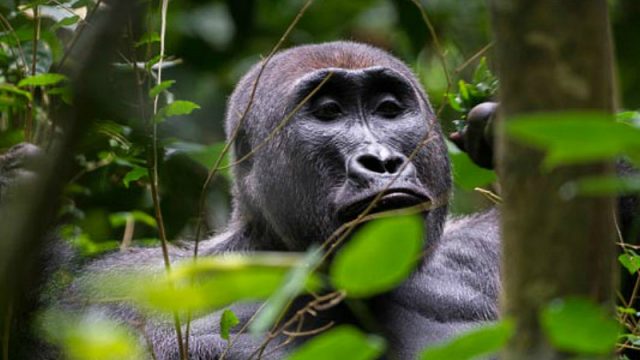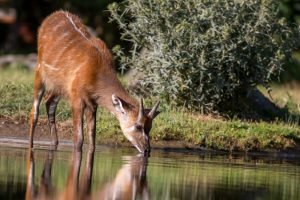Even in a country where tourism is in its infancy, the untamed tropical rainforests of the Odzala-Kokoua National Park in the Republic of Congo are, by any standard, off the beaten track. It’s a 14-hour journey from Brazzaville to the forests of Odzala, and while flights into the Mboko airstrip can shorten the journey, the journey is well worth the long hours in the car.
For as dawn breaks over the empty plains of central Congo, the villages that dot the roadside tell the tale of everyday life. Cassava is dried and ground into flour, while village bakeries turn out delicious fresh baguettes each morning, a remnant of the country’s long years as a French colony. In roadside restaurants sweet coffee is served, while old ladies hunch over pots of boiling oil to dish out small paper packets of piping-hot deep-fried doughnuts. Shops piled high with colorful Chinese goods are here too, squeezed in alongside the rustic butcheries and ubiquitous dance halls.
As the N2 highway snakes its way north, the scrub gives way to grasslands, and before long the trees begin to appear. First a handful, then sturdy stands of towering hardwoods. These are the pioneer forests nibbling at the edges of the savannah. By the time you reach the town of Etoumbi, the rainforests of Odzala are within reach just across the Likouala River.
For aside from the streets of Brazzaville and the beaches of Pointe Noire, the northern rainforests of the Odzala-Kokoua National Park are one of the few tourist highlights in the Republic of Congo. And understandably so.
The forests here, as part of the greater Congo River basin, make up the second-largest rainforest on the planet, second only to the Amazon. These species-rich woodlands cover the heart of the continent, stepping over arbitrary international boundaries to take in Congo, the Democratic Republic of Congo, Gabon, Cameroon and the Central African Republic.
While the region is criss-crossed by a handful of muddy roads, used largely by cross-border traders and logging companies harvesting the forests to the north, it’s an area that appears almost impenetrable. A pristine forest wilderness, in many places untouched by man, and subject to admirable conservation work by the African Parks foundation.
Until recently tourism here was all but unheard of, until the Odzala Discovery Camps were established with a view to opening up low-impact eco-tourism to the region. Today, the three Discovery Camps offer one of the most remarkable wilderness experiences in Africa. Happily, it’s also a multifaceted experience, with each camp offering an entirely different outlook on the remarkable forests of Odzala.
For most visitors Ngaga Camp on the outskirts of the National Park is the first stop. Hidden away amid thick forests in and around the eponymous Ngaga River, the rainforests here teem with colourful forest birds, shy antelope and raucous monkeys. And yet there is just one animal most travellers have come to see: gorilla.
Unlike their high-altitude cousins common in Uganda and Rwanda, the Western Lowland Gorilla is what you’ll find here, the families feasting on the rich marantaceae vegetation that thrives beneath the high forest canopy. And, as with gorilla treks in other parts of Africa, the walks to observe the two habituated families near the camp are strictly controlled.
Each day forest walks set out from the lodge at dawn in a bid to locate the gorilla families once they have left their overnight nest. Highly trained trackers lead the group, sharing their knowledge en route. The gorilla families move constantly while feeding, so the walk to locate them can take anywhere from 30 minutes to three hours.
Any tired legs are instantly forgotten though when your ears prick up at the first crash of gorilla through the vegetation. A tingle runs down your spine as the guide motions guests into a quiet copse of marantaceae, the gorillas mere meters away. For an hour guests have the unique privilege of observing the foraging and family rituals of these utterly wild primates. Amid a rainforest that stretches over 200,000 square kilometers, an hour spent in the company of these remarkable wild animals is a memory not soon forgotten.
For our group, it was just past an hour when the dominant male silverback called time, striding forward on powerful front arms. Time’s up, he seemed to grunt. We weren’t going to argue, and wandered happily back to the lodge.
Aside from the opportunity to enjoy repeat sightings, it’s well worth spending a few nights at Ngaga Camp. The handful of forest suites sit serenely on stilts high above the leafy floor, your private balcony perched amid the boughs. Sit quietly for a moment and the forest around you soon springs to life as colourful Turacos and Grey Parrots begin their canopy cacophony.
After a few days it’s time to move on, and from Ngaga it’s a mesmerising three-hour drive into the national park and Mboko Camp, set on the fringes of the Ndzehi Forest.
Here it’s another gentle giant that is the star attraction: Forest Elephants are a remarkable sighting in the thick forests of Odzala, not least when seen from the wobbly seat of a pirogue.
For while Ngaga Camp revels in the embrace of the forest, Mboko lies amid grasslands and dramatic rivers that drain the very heart of Africa, and daily pirogue and speedboat excursions on the Lekoli River take guests deep into the heart of Odzala’s magnificent forests.
From the water a different world emerges, of African fish eagles atop lonely treetops, and monkeys cavorting above the banks. If you’re lucky, the rare Sitatunga will reveal themselves. These shy semi-aquatic antelope are common in the region; yet prefer to hide in the forest shadows. Where the river widens into a shallow clearing known as a ‘bai’, elephant come to feed and seek out the salt rich soils. Forest Buffalo can be seen here too, their rear facing horns a perfect adaptation for picking their way through the thick undergrowth.
At Lango bai the entire scene unfolds from the spacious deck of Lango Camp, the final camp in the circuit. Here just six rooms share this remarkable corner of forest, with private terraces overlooking the bai. Come sunset, the fires are lit on the communal deck and the gin-and-tonics are poured.
For while this may be the wildest corner of a country taking its first tentative steps in wilderness tourism, there’s no shortage of creature comforts on offer. It’s a long and bumpy road to Odzala, but for the traveller who’s ticked the Serengeti, Okavango and Namib off their travelling bucket lists, the rainforests of northern Congo should be your next stop in the heart of Africa.
Related content on AFKTravel:
The Muddy Heart Of Africa: A Travellers’ Guide To The Republic Of Congo
Bold, Brash Brazzaville: Exploring Congo’s Capital
Mysterious Waters: 10 Things You Didn’t Know About The Congo River



